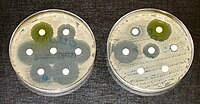
Photo from wikipedia
AIMS Data on antimicrobial resistance (AMR) in the pediatric patient population are scarce. Here, we assess the AMR rates and phenotype distribution of Gram-negative isolates in pediatric patients in Europe… Click to show full abstract
AIMS Data on antimicrobial resistance (AMR) in the pediatric patient population are scarce. Here, we assess the AMR rates and phenotype distribution of Gram-negative isolates in pediatric patients in Europe from 2004-2012 and 2013-2018. METHODS Isolates collected were stratified by age groups (<1, 1-5, 6-12, 13-17 years) and regions (North-Western, Eastern, and Southern Europe). Minimal inhibitory concentrations (broth microdilution) were interpreted according to European Committee on Antimicrobial Susceptibility Testing guidelines. Resistance rates and phenotype prevalence were identified for Escherichia coli, Klebsiella pneumoniae, Enterobacter cloacae, Acinetobacter baumannii, Pseudomonas aeruginosa, and Haemophilus influenzae . RESULTS In the overall pediatric patient population (0-17 years), extended-spectrum beta-lactamase (ESBL) production significantly decreased (from 20.7% to 15.4%, P<0.0001) in E. coli, whereas it increased for K. pneumoniae (from 35.0% to 39.2%, P=0.015). Carbapenem resistance was highest for A. baumannii (32.3%) as compared to K. pneumoniae (4.7%) and P. aeruginosa (12.4%) in 2013-2018 and rates were significantly increased relative to 2004-2012. For H. influenzae, there was no change in resistance to beta-lactam antimicrobials. Lowest resistance rates for most organism groups were observed in North-Western Europe. CONCLUSIONS Our results reveal a significant increase in K. pneumoniae isolates with an ESBL and carbapenem resistance phenotype as well as in carbapenem-resistant A. baumannii and P. aeruginosa from 2004-2012 to 2013-2018. Conversely, we observed a decrease in ESBL E.coli . Continued surveillance and awareness of resistance in these bacteria causing serious infections is crucial for improving treatment quality in pediatric patients.
Journal Title: International journal of antimicrobial agents
Year Published: 2021
Link to full text (if available)
Share on Social Media: Sign Up to like & get
recommendations!